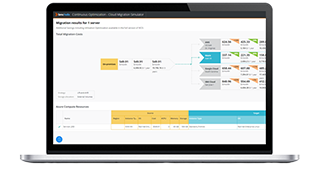Companies getting started with cloud technology usually opt for a single-cloud approach, almost unintentionally, simply because it makes sense: they want to start by putting some of their data in the cloud, and they might only need one or two specific functionalities.
As the company grows comfortable and more fully embraces the cloud and its benefits, moving towards a multi-cloud approach is common. At first glance, a multi-cloud approach can seem more complicated, but look closer – multi-cloud can actually offer a range of benefits, not least a significant cost savings.
(This article is part of our IT Cost Management Guide. Use the right-hand menu to navigate.)
Distinguishing clouds
Not all clouds are the same. Getting started with cloud technology can feel overwhelming because there are a whole host of questions you’re supposed to know the answer to: public or private cloud? Hybrid or not? Single- or multi-cloud? Who’s managing the cloud?
For clarity, a single-cloud environment is generally understood as a company opting for just one cloud provider to serve all cloud-related applications. If you’re working with a third-party cloud vendor, it’s likely a public cloud (that’s not to say your information is publicly available, just that other companies are also utilizing the third-party cloud). A private cloud is one that you house and manage directly, often to protect sensitive data.
As a company wants more services from their cloud, they can continue to stick with a single vendor, especially if it’s a big provider, like AWS, Google, Microsoft, or IBM. These large providers have a range of tools, SaaS, and IaaS options, so companies can branch into more services without having to shop for the perfect fit.
But, there’s a caveat to this “one stop shop” approach. Vendors that have a variety of services tend to be more expensive, something the industry dubs “vendor lock-in”. Vendor lock-in can be problematic because, if you’re dedicated to a single cloud provider, you may be forced into choosing a less-than-optimal solution because that’s all they’ve got.
One way to leverage cost savings and avoid vendor lock-in? Going multi-cloud.
Multi-cloud for multi-purposes
When your single-cloud “solution” feels less and less like it’s solving your custom problems, you may be ready to migrate to a multi-cloud environment. Multi-cloud environments are any combination of clouds, from a variety of vendors. You may opt for a Google or Microsoft Azure product for volume or sheer computing power, but smaller, independent cloud solutions may address more specific needs. Indeed, you may still keep some data in private, on-prem servers, a set-up known as hybrid-cloud. (Some tech experts say that the multi-cloud is probably most accurately described as multi-hybrid-cloud.)
There are several benefits to the multi-cloud route, like avoiding vendor lock-in, optimizing your performance for as many services as you need, increasing reliability, and decreasing your risk of security attacks. When you’ve separated workloads across a variety of clouds, you can have more work happening independently, quickly, and, if planned well, more efficiently.
The most compelling reason may just be cost savings, and efficiency is key to cost savings. When you break free of vendor lock-in, you can start prioritizing how to spend money, not just how much to spend.
The way you spend your money is unique to your company’s needs. You can go all-in pricewise for a really important, high-end solution for your core business need and then seek more affordable options for less vital projects or processes. Another approach is scaling up or down depending on your needs, which lets you spend money when you’ve got it but save big when it’s necessary. Or, build automation into processes that turn off resources when they’re not needed, offering reliable cost savings.
Monthly or quarterly reviews on cloud spending can help you stay on top of whether you’re spending too much or estimating too little. The overarching principle is that when you have the right workload in the right cloud at the right time, you’ll get the most bang for your buck.
While shifting to the multi-cloud can be overwhelming because the sheer volume of choices, a DevOps concern is one of integration. How do you get the relevant cloud technologies to speak to each other when they’re all different?
Certainly this is a concern to be proactive about. Luckily, software companies are beginning to provide solutions to the issue of multi-cloud integration. New data control interfaces that sit on top of the cloud interfaces provide a single endpoint for storing, managing, searching, and retrieving data. Thanks to their agnostic approach, they can smoothly navigate across private and public as well as big-name and more specific clouds.
Choosing between single- or multi-cloud
As with most things in technology, each company has different needs, expectations, and budgets, and the right combination is one that’s often reached through trial and error. Though multi-cloud can seem intimidating, the cost savings are often worth the initial exploration. At the very least, consider the opposite – sticking with the single-cloud.
The U.S. Department of Defense is a perfect example of the single- versus multi-cloud debate. They are in the midst of shopping their Joint Enterprise Defense Infrastructure (JEDI) to potential contractors. The 10-year contract that, when awarded, can be worth up to $10 billion for the winning firm. JEDI aims to bring DoD processes to the cloud, but with one big catch: they are insisting on one cloud computing provider – a single-cloud approach.
Critics are weary that this vital work (DoD includes the Army, Navy, Air Force, and several intelligence branches, among other sensitive missions) will pigeonhole the Department into a single vendor’s approach. Whether DoD chooses AWS, as rumored, or another big cloud provider, will their work get to take advantage of innovation or will it wall off the DoD from advances in security and data analytics?
The government may have its own reasons for choosing a single-cloud approach. Most private enterprises, however, seem to crave the flexibility to shop around for the best cloud solution – unique to them – in a way that only multi-cloud can solve.
Of course, for utmost cost savings, you’ll need to get away from external clouds altogether. As long as you’re paying for someone else’s infrastructure, you’re paying more than the absolute lowest price. You could always go the Dropbox route and move the vast majority of your data to in-house clouds, saving huge on OpEx. (But, then again, that option has a lot of drawbacks, too.)





